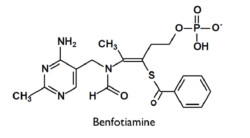Benfotiamine Interactions Overview
Check For Interactions With Benfotiamine
Benfotiamine
- S-benzoylthiamine O-monophosphate
 Benfotiamine is a synthetic derivative of thiamine (vitamin B1) with enhanced bioavailability. It is often used as a dietary supplement to support overall health and address conditions related to thiamine deficiency. Unlike thiamine, benfotiamine is lipid-soluble, allowing it to penetrate cell membranes more effectively. This enhanced absorption is believed to contribute to its potential therapeutic benefits in managing diabetic complications, neuropathy, and oxidative stress.
Benfotiamine is a synthetic derivative of thiamine (vitamin B1) with enhanced bioavailability. It is often used as a dietary supplement to support overall health and address conditions related to thiamine deficiency. Unlike thiamine, benfotiamine is lipid-soluble, allowing it to penetrate cell membranes more effectively. This enhanced absorption is believed to contribute to its potential therapeutic benefits in managing diabetic complications, neuropathy, and oxidative stress.
Additional Details
Is Benfotiamine Safe? Are There Any Warnings?
Benfotiamine is generally considered safe when taken orally and in appropriate doses. Studies have shown its safety at doses ranging from 150 to 600 mg daily for up to 24 weeks. However, caution is advised during pregnancy and lactation due to insufficient information about its safety in these situations.
How Does Benfotiamine Work? What is the Mechanism of Action?
Benfotiamine, a derivative of vitamin B1, works by being converted into active thiamine in the body. Unlike traditional thiamine, benfotiamine is fat-soluble, providing better absorption and increased bioavailability. It not only elevates thiamine levels but also exhibits unique effects, including anti-inflammatory, antioxidant, antitumor, cognitive, and glycemic impacts.
Pharmacokinetics
Absorption: Benfotiamine is absorbed through the intestinal mucosa via passive diffusion. Its fat-soluble nature gives it higher bioavailability than water-soluble thiamine, and it is not significantly affected by food.
Distribution: As a fat-soluble prodrug, benfotiamine has a large volume of distribution.
Metabolism: After absorption, benfotiamine transforms into thiamine via a reduction reaction, leading to the subsequent production of thiamine monophosphate and thiamine diphosphate.
Excretion: The plasma half-life of thiamine after benfotiamine administration is approximately 1-2.5 hours.
Interaction Overview
Drugs: No known interactions with drugs.
Supplements: No known interactions with supplements.
Conditions: No known interactions with specific health conditions.
Lab Tests: No known interactions with lab tests.
Common Side Effects To Watch For
Orally administered benfotiamine is generally well-tolerated. However, comprehensive safety evaluations are lacking, and specific side effects may vary.
Are Supplements Standardized?
Benfotiamine is commonly available in tablet or capsule form, with a proprietary oral formulation called Benfogamma. This formulation, containing 40-50 mg per tablet or capsule, has undergone extensive clinical research.
What Is Benfotiamine Typically Used For?
Possibly Effective For: Diabetic neuropathy, showing potential in improving symptoms.
Possibly Ineffective For: Diabetic nephropathy; research suggests limited efficacy in improving markers.
Insufficient Evidence For: Alcohol use disorder, Alzheimer's disease, osteoarthritis, peripheral neuropathy induced by alcohol, rheumatoid arthritis. More research is needed for conclusive evidence in these areas.
Drugs that interact with Benfotiamine
Return to the main supplement interaction checker page
Parts of this content are provided by the Therapeutic Research Center, LLC.
DISCLAIMER: Currently this does not check for drug-drug interactions. This is not an all-inclusive comprehensive list of potential interactions and is for informational purposes only. Not all interactions are known or well-reported in the scientific literature, and new interactions are continually being reported. Input is needed from a qualified healthcare provider including a pharmacist before starting any therapy. Application of clinical judgment is necessary.
© 2021 Therapeutic Research Center, LLCs